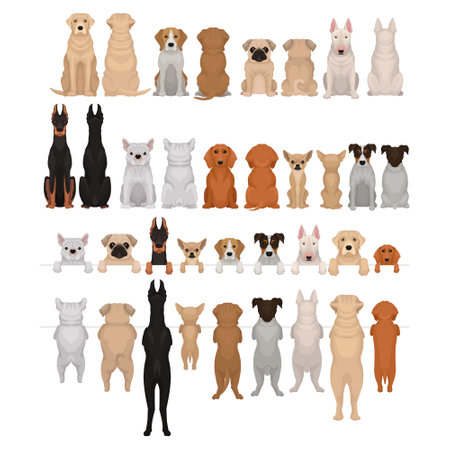1. The Science Behind Dog Sleep Cycles
Just like humans, dogs go through different sleep stages that play a crucial role in their overall health and well-being. Understanding these cycles can help pet owners ensure their furry friends get the rest they need.
How Do Dogs Sleep?
Dogs experience sleep in cycles, alternating between light sleep, deep sleep, and REM (Rapid Eye Movement) sleep. While the duration of each stage differs from human sleep patterns, the structure remains somewhat similar.
Comparing Dog and Human Sleep Patterns
The table below highlights key differences between dog and human sleep cycles:
| Sleep Factor | Dogs | Humans |
|---|---|---|
| Total Sleep Time | 12-14 hours per day (varies by breed and age) | 7-9 hours per night |
| REM Sleep Duration | Around 10% of total sleep time | Around 25% of total sleep time |
| Sleep Cycle Length | Around 20 minutes per cycle | Around 90 minutes per cycle |
| Napping Behavior | Takes multiple short naps throughout the day | Mainly sleeps in one long period at night |
The Role of REM Sleep in Dogs
The REM stage is when dreaming occurs. During this phase, you may notice your dog twitching, moving their paws, or even making small noises. This suggests they are experiencing vivid dreams, much like humans do.
Why Is REM Sleep Important?
This stage is essential for cognitive function, memory processing, and overall mental health. Puppies and younger dogs tend to spend more time in REM sleep as they process new experiences and learn about the world around them.
2. What Is REM Sleep and Why It Matters
Just like humans, dogs go through different sleep cycles, including the Rapid Eye Movement (REM) stage. This phase of sleep is crucial for their overall health and well-being. But what exactly happens during REM sleep, and why is it so important for your furry friend?
Understanding REM Sleep in Dogs
REM sleep is a deep sleep stage where the brain becomes highly active, even though the body remains relaxed. It is during this time that dreaming occurs, which explains why you might see your dog twitching, paddling their paws, or even making soft noises while asleep.
Key Characteristics of REM Sleep
| Characteristic | Description |
|---|---|
| Rapid Eye Movement | The eyes move quickly under the eyelids, indicating high brain activity. |
| Muscle Relaxation | The body remains mostly still, but slight twitches or movements may occur. |
| Irregular Breathing | Your dogs breathing may become shallow or irregular during this phase. |
| Dreaming | This is when dogs are most likely to experience dreams, replaying daily activities. |
Why Is REM Sleep Important for Dogs?
Adequate REM sleep plays a vital role in maintaining your dogs physical and mental health. Without enough of it, dogs can experience behavioral issues, memory problems, and increased stress levels.
The Benefits of REM Sleep for Your Dog
- Cognitive Function: Helps process memories and improve learning ability.
- Mood Regulation: Reduces anxiety and promotes emotional stability.
- Nervous System Health: Supports brain development and function.
- Physical Restoration: Aids in muscle recovery and overall energy levels.
The Connection Between REM Sleep and Dreaming
If youve ever noticed your dog wagging its tail or softly barking in its sleep, its likely experiencing a dream. Scientists believe dogs dream about their daily experiences, such as playing fetch or interacting with family members. Ensuring your dog gets enough uninterrupted rest allows them to fully benefit from these essential dream cycles.

3. Do Dogs Really Dream?
Have you ever watched your dog twitch, whimper, or move their legs while sleeping? Many pet owners wonder if their furry friends are dreaming just like humans do. Scientific research and behavioral observations suggest that dogs do, in fact, experience dreams similar to our own.
Scientific Studies on Canine Dreaming
Researchers have studied canine sleep patterns extensively, and the results indicate that dogs go through sleep cycles much like humans. One of the most important discoveries is that dogs experience Rapid Eye Movement (REM) sleep, which is the stage most associated with dreaming.
Key Findings from Research
| Study | Findings |
|---|---|
| MIT Study on Mammalian Dreams | Researchers found that rats replay memories in their sleep, suggesting that dogs might do the same. |
| Harvard University Research | Experts believe dogs dream about everyday experiences, such as playing or interacting with their owners. |
| EEG Sleep Monitoring Studies | Brain wave patterns in sleeping dogs closely resemble those of dreaming humans. |
Behavioral Observations That Suggest Dogs Dream
If youve noticed your dog moving in their sleep, it’s likely they are acting out a dream. Here are some common signs that suggest dogs are dreaming:
- Paw Twitching: Dogs may move their legs as if they are running.
- Whimpering or Barking: Some dogs make noises during REM sleep.
- Facial Movements: You might see slight movements around their eyes and mouth.
- Tail Wagging: A happy dream may cause tail movement.
What Do Dogs Dream About?
While we can’t know for sure what goes on in a dog’s mind, experts believe their dreams reflect daily experiences. A dog that spent the day playing at the park might dream of chasing a ball, while another could relive interactions with their owner.
Do Different Breeds Dream Differently?
The size and breed of a dog may influence how often and how vividly they dream. Studies suggest that smaller breeds tend to have more frequent but shorter dreams, whereas larger breeds experience longer but less frequent dreams.
| Dog Size | Dream Frequency | Dream Duration |
|---|---|---|
| Small Breeds (e.g., Chihuahuas) | More Frequent | Shorter Dreams |
| Large Breeds (e.g., Labrador Retrievers) | Less Frequent | Longer Dreams |
The idea that dogs dream is supported by both scientific studies and everyday observations. Next time you see your pup moving in their sleep, theres a good chance they’re reliving their favorite moments!
4. Signs Your Dog Might Be Dreaming
If youve ever watched your dog sleep, you may have noticed some interesting movements and sounds. Just like humans, dogs experience different sleep stages, including REM (Rapid Eye Movement) sleep, where dreaming occurs. During this phase, your pup might exhibit certain behaviors that indicate they are deep in dreamland.
Common Signs of Dreaming
When dogs dream, their brains are active, and this can result in physical reactions. Here are some common signs that suggest your furry friend is having a dream:
| Behavior | Description |
|---|---|
| Twitching | Your dogs paws, ears, or facial muscles may twitch as they react to dream stimuli. |
| Leg Movement | You might see your dog’s legs moving as if they are running or chasing something in their dream. |
| Whimpering or Barking | Your pup may let out small barks, whimpers, or even growls depending on the dream scenario. |
| Rapid Eye Movement | Their eyes may move quickly under closed lids, which is a key indicator of REM sleep. |
| Breathing Changes | You might notice irregular breathing patterns, such as quick breaths or soft sighs. |
Should You Wake a Dreaming Dog?
If your dog is dreaming, it’s generally best to let them be. Waking them suddenly could startle them and cause confusion. However, if your dog appears distressed or is having what seems like a nightmare, you can gently call their name to wake them without touching them abruptly.
A Peek Into Their Dream World
The next time you see your pup twitching or softly barking in their sleep, imagine what adventure they might be experiencing. Whether they’re chasing squirrels or playing with their favorite toy in dreamland, its fascinating to know that dogs likely dream just like we do!
5. How to Ensure Your Dog Gets Quality Sleep
Just like humans, dogs need quality sleep to stay healthy and happy. Ensuring your furry friend gets enough rest can improve their mood, behavior, and overall well-being. Here are some practical tips for creating a comfortable sleep environment and promoting healthy rest habits for your dog.
Creating a Comfortable Sleep Environment
Your dogs sleeping space plays a crucial role in the quality of their rest. A peaceful and cozy area can help them relax and sleep better.
Choosing the Right Bed
The type of bed your dog sleeps on can make a big difference in their comfort. Consider factors like size, material, and support when selecting a bed.
| Bed Type | Best For |
|---|---|
| Orthopedic Bed | Seniors or dogs with joint issues |
| Cushioned Bolster Bed | Dogs who like head support |
| Nest or Donut Bed | Curling-up sleepers who need warmth |
| Cooling Mat Bed | Pups who overheat easily |
Setting Up a Quiet Sleeping Area
A noisy environment can disrupt your dog’s sleep. Choose a quiet location away from household traffic, loud TVs, or other pets that may disturb them during the night.
Establishing Healthy Sleep Habits
Create a Consistent Sleep Routine
A regular schedule helps regulate your dog’s internal clock. Try to feed, walk, and put them to bed at the same times each day.
Adequate Exercise Before Bedtime
A tired dog sleeps better! Make sure they get enough physical activity during the day so they’re ready to rest at night.
Avoid Late-Night Feeding and Water Intake
A full stomach or excessive water intake before bedtime can lead to frequent wake-ups for bathroom breaks. Try feeding your dog earlier in the evening to prevent disruptions.


